Introduction
In the world of digital marketing and sales, data is everything. But not all data is created equal. Inaccurate, incomplete, or outdated records can wreck your targeting, waste resources, and hurt conversion rates. That’s where Waterfall Enrichment comes in—a structured process that pulls data from multiple sources in a prioritized sequence to ensure maximum accuracy and completeness.
Unlike a one-and-done data enrichment approach, waterfall enrichment improves your datasets by layering in fresh, verified details step by step. The result? Smarter segmentation, better personalization, and higher ROI. In this article, we’ll break down how waterfall enrichment works, why it matters, and how you can implement it to optimize your marketing and sales strategies.
What is Waterfall Data Enrichment?
Waterfall Data Enrichment is a multi-layered approach to improving data accuracy and completeness by sequentially sourcing information from multiple providers in a structured, prioritized manner. Unlike traditional enrichment, which relies on a single data source, waterfall enrichment ensures that every data point is verified, filled, and cross-checked across multiple sources before finalizing the record.
How It Works
The process follows a prioritized sequence, much like a traditional waterfall methodology in project management:
- Primary Data Source Check – The first and most trusted source is used to enrich the data. If all key fields are available, the process stops here.
- Secondary Data Source Check – If data is missing, the system queries a second, reputable data provider to fill in the blanks.
- Tertiary Data Source Check – If necessary, the process continues down the chain, enriching the dataset with the next best available sources.
- Final Validation & Standardization – Once data has been enriched across multiple layers, it goes through a final verification and formatting process to ensure consistency and usability.
- Continuous Updates – Waterfall enrichment isn’t a one-time process. The best systems refresh and update data on an ongoing basis to maintain accuracy over time.
Waterfall Enrichment vs. Traditional Enrichment
Most companies rely on a single data provider to enrich their customer and prospect records. The problem? No single data vendor has 100% coverage or accuracy. Waterfall enrichment mitigates this risk by pulling data from multiple sources, ensuring you always get the best available information.
Here’s how it outperforms traditional enrichment:
✅ Higher Accuracy – Combines multiple sources to verify and cross-check data points.
✅ Better Completeness – Fills in missing details that a single provider might lack.
✅ More Reliable Insights – Helps sales and marketing teams make data-driven decisions with confidence.
✅ Reduced Costs & Waste – Avoids the inefficiencies of bad data that lead to poor targeting and outreach failures.
Real-World Use Cases
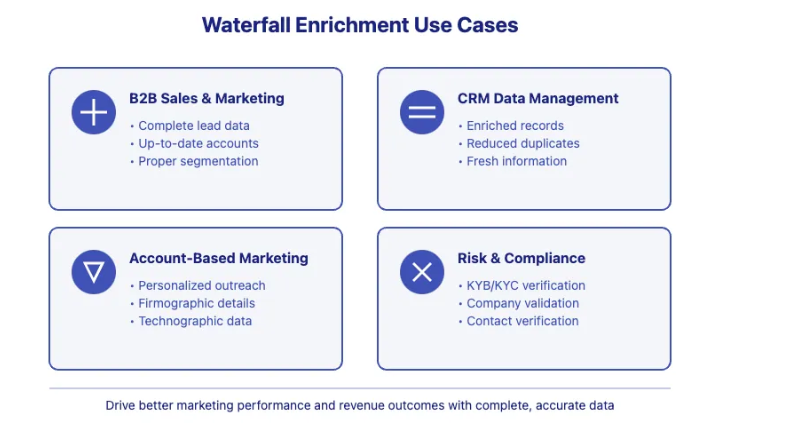
Waterfall enrichment is particularly useful for
✔B2B Sales & Marketing – Ensuring lead and account data is complete, up-to-date, and segmented properly.
✔CRM Data Management – Keeping customer records enriched, reducing duplicates, and preventing outdated information.
✔Account-Based Marketing (ABM) – Personalizing outreach with accurate firmographic and technographic details.
✔Risk & Compliance – Enhancing KYB/KYC verification with robust company and contact data.
By implementing a waterfall enrichment strategy, businesses can ensure that every contact record, company profile, and customer touchpoint is as accurate and complete as possible, driving better marketing performance and revenue outcomes.
Implementing Waterfall Enrichment in Your Strategy
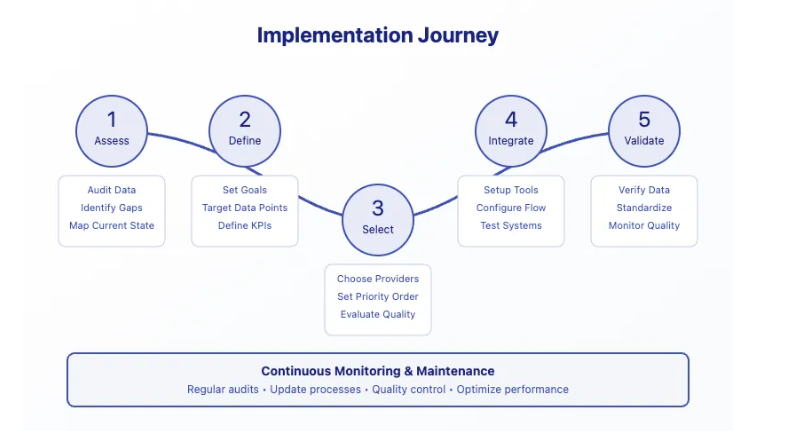
Integrating waterfall enrichment into your digital marketing strategy can significantly enhance your data quality, leading to more effective campaigns and improved ROI. Here's a step-by-step guide to implementing this approach:
1.Assess Your Current Data Quality
✔ Audit Existing Data: Begin by evaluating the completeness and accuracy of your current datasets. Identify gaps, outdated information, and inconsistencies that could hinder your marketing efforts.
2. Define Your Data Enrichment Objectives
✔Set Clear Goals: Determine what specific data points you need to enrich—such as email addresses, phone numbers, job titles, or company details—to enhance your marketing initiatives.
3.Select and Prioritize Data Providers
✔Research Vendors: Identify multiple reputable data providers that specialize in the information you require. Consider factors like data accuracy, coverage, compliance with data privacy regulations, and cost
✔Establish a Sequence: Arrange your chosen data providers in a prioritized order. Start with the most reliable source and proceed to secondary options if the primary source doesn't yield the necessary data.
4.Integrate Enrichment Tools into Your Workflow
✔Leverage Automation Platforms: Utilize tools and platforms that support waterfall enrichment processes. For instance, platforms like Clay offer features that automate data enrichment by sequentially accessing multiple data sources, ensuring comprehensive and accurate data collection.
✔Configure Data Flow: Set up your system to automatically pass data through your prioritized list of providers until all desired information is obtained. This minimizes manual intervention and reduces the risk of errors.
5. Validate and Standardize Enriched Data
✔Implement Verification Steps: After enrichment, validate the new data to ensure its accuracy. Use verification tools to confirm email addresses, phone numbers, and other critical information.
✔Standardize Data Formats: Ensure that all enriched data adheres to a consistent format within your CRM or marketing platforms. This consistency is crucial for effective segmentation and analysis.
6.Monitor and Maintain Data Quality
✔Regular Audits: Continuously monitor your data for accuracy and completeness. Schedule regular audits to identify and rectify any emerging issues.
✔Update Enrichment Processes: As your business needs evolve, revisit and adjust your waterfall enrichment strategy. This may involve incorporating new data sources or updating existing ones to maintain optimal data quality.
By systematically implementing waterfall enrichment, you can transform incomplete or outdated data into a robust asset, driving more personalized and effective marketing campaigns.
Benefits of Waterfall Enrichment
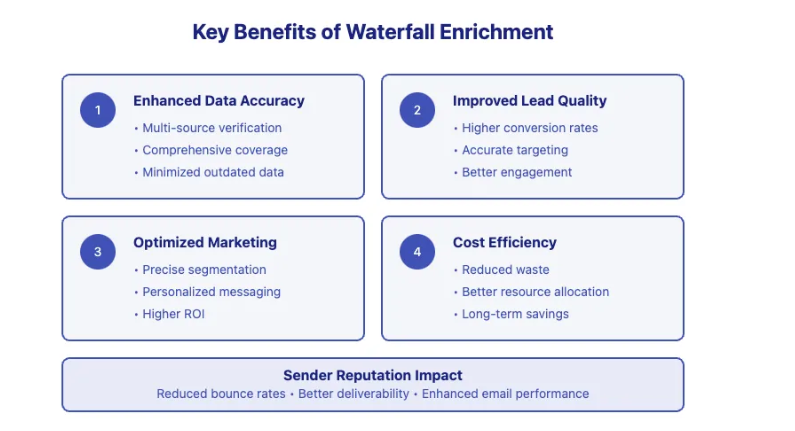
Implementing waterfall enrichment in your data strategy offers several key advantages that can significantly enhance your marketing and sales efforts:
1. Enhanced Data Accuracy and Completeness
By sequentially sourcing information from multiple data providers, waterfall enrichment ensures that your datasets are both accurate and comprehensive. This multi-layered approach minimizes the risk of relying on outdated or incorrect data, leading to more reliable insights.
2. Improved Lead Quality and Conversion Rates
With enriched and verified data, your sales team can focus on high-quality leads that are more likely to convert. Accurate contact information and detailed prospect insights enable personalized outreach, increasing the chances of successful engagements.
3. Optimized Marketing Campaigns
Access to detailed and accurate data allows for better segmentation and targeting in your marketing campaigns. Personalized messaging based on enriched data resonates more with your audience, leading to higher engagement and conversion rates.
4. Cost Efficiency
While setting up a waterfall enrichment process may require an initial investment, the long-term benefits include reduced wasted resources on ineffective outreach and improved ROI from marketing campaigns. By maintaining a clean and accurate database, you avoid the costs associated with poor data quality.
5. Strengthened Sender Reputation
Maintaining accurate email lists through waterfall enrichment reduces bounce rates and spam complaints, thereby protecting your sender reputation. A good sender reputation ensures that your emails reach the intended recipients' inboxes, enhancing the effectiveness of your email marketing efforts.
Challenges and Considerations in Implementing Waterfall Enrichme
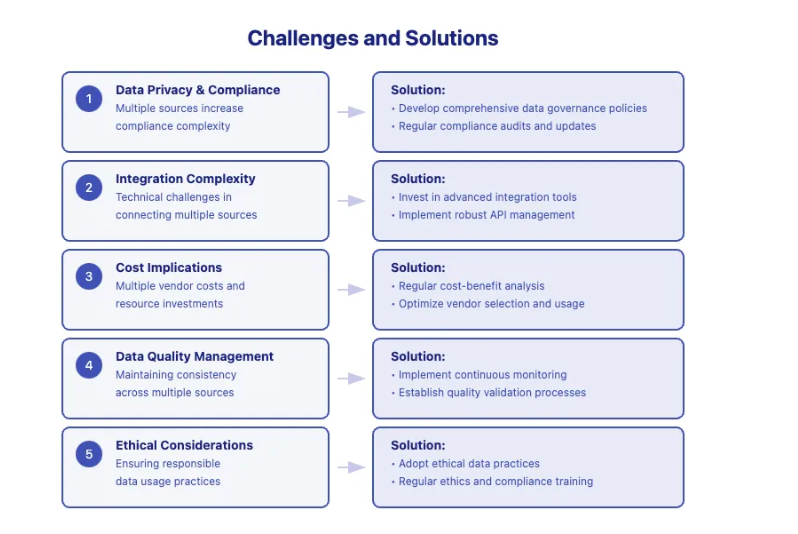
While waterfall enrichment offers significant advantages in enhancing data quality, its implementation is not without challenges. Being aware of these potential hurdles can help in developing effective strategies to mitigate them.
1. Data Privacy and Compliance
Handling data from multiple sources increases the complexity of ensuring compliance with data privacy regulations such as GDPR or CCPA. Each data provider may have different standards and practices, making it essential to establish robust data governance policies to maintain compliance.
2. Integration Complexity
Incorporating multiple data sources into existing systems can be technically challenging. Ensuring seamless integration requires careful planning and possibly significant adjustments to your current data infrastructure. Technical expertise is crucial to manage these integrations effectively.
3. Cost Implications
Utilizing multiple data vendors can lead to increased costs, especially when specialized or premium data sources are involved. It's important to balance the benefits of enriched data against these additional expenses to determine the overall return on investment.
4. Maintaining Data Quality Across Sources
Ensuring consistent data quality when aggregating information from various providers is a significant challenge. Discrepancies in data formats, accuracy, and timeliness can lead to inconsistencies, requiring ongoing monitoring and validation processes to maintain data integrity.
5. Ethical Considerations
The practice of waterfall enrichment, particularly in email marketing, raises ethical concerns. Relying on outdated databases or unverified information can lead to the dissemination of inaccurate data, potentially damaging trust and leading to legal issues. It's essential to ensure that data enrichment practices are ethical and that the data used is accurate and up-to-date.
Strategies to Overcome These Challenges
✔Develop Comprehensive Data Governance Policies: Establish clear guidelines to ensure data privacy and compliance across all sources.
✔Invest in Integration Capabilities: Utilize advanced tools and platforms that facilitate seamless integration of multiple data sources.
✔Conduct Cost-Benefit Analyses: Regularly assess the financial implications of using multiple data vendors to ensure a positive return on investment.
✔Implement Continuous Monitoring: Set up processes to regularly monitor and validate data quality across all sources.
✔Adopt Ethical Data Practices: Ensure that all data enrichment activities are conducted ethically, with a focus on accuracy and respect for privacy.
Case Studies and Examples
Waterfall Enrichment is not just a theory—it’s a proven strategy that has helped businesses across industries improve data accuracy, optimize lead generation, and enhance due diligence processes. Below are three real-world applications showcasing its impact.
1. Enhancing Lead Generation in CRM with Waterfall Enrichment
Challenge:
A fast-growing B2B SaaS company struggled with low conversion rates in their outbound marketing campaigns. Their CRM was filled with incomplete prospect records, missing emails, phone numbers, job titles, and company details, making it difficult for the sales team to personalize outreach and prioritize high-value leads.
Solution:
They implemented a waterfall enrichment strategy using Global Database as the primary source, which verified company registration, revenue, industry, and executive data. For missing emails and direct dials, the system then queried Apollo and BetterContact, ensuring maximum contact data coverage.
Results:
📈 Email match rate increased by 47%
📈 Sales team improved outreach efficiency by 35%
📈 Lead response rates improved by 22%
By automating waterfall enrichment, the company dramatically reduced wasted sales efforts, leading to higher engagement and increased conversions.
2. Better Due Diligence with Multi-Layered Verification
Challenge:
A private equity firm needed a faster, more accurate way to conduct due diligence on potential investment opportunities. Relying on single-source company data led to incomplete risk assessments, as critical information on ownership structure, financial performance, and past regulatory violations was often missing.
Solution:
The firm adopted Global Database as the foundation of its due diligence process, verifying company registration, shareholders, and UBO structures. If any gaps existed, they ran additional checks with financial data providers and legal databases. This multi-step enrichment process ensured that every investment decision was backed by verified intelligence.
Results:
✅ Identified 28% more high-risk entities before investment
✅ Reduced due diligence time by 40%
✅ Increased compliance with AML and KYC regulations
By using waterfall enrichment to cross-check multiple authoritative sources, the firm minimized financial risk and made more informed investment decisions.
3. Improving Global Data Coverage for a Multinational Corporation
Challenge:
A Fortune 500 company with global operations required comprehensive and up-to-date business intelligence across multiple markets. Their existing data providers had strong coverage in North America and Western Europe but lacked depth in emerging markets like Latin America, Asia, and Africa.
Solution:
The company integrated Global Database to fill in missing business registration, revenue, and ownership details from government sources. They then used local data providers and credit bureaus to enhance records in regions where global coverage was limited.
Results:
🌎 Expanded data coverage from 75 to 110 countries
📊 Reduced data gaps by 60% in emerging markets
🔍 Improved market intelligence for regional expansion strategies
By implementing Waterfall Enrichment, the company built a truly global dataset, empowering their sales, compliance, and strategy teams with accurate, country-specific business intelligence.
Tools and Platforms for Waterfall Enrichmen
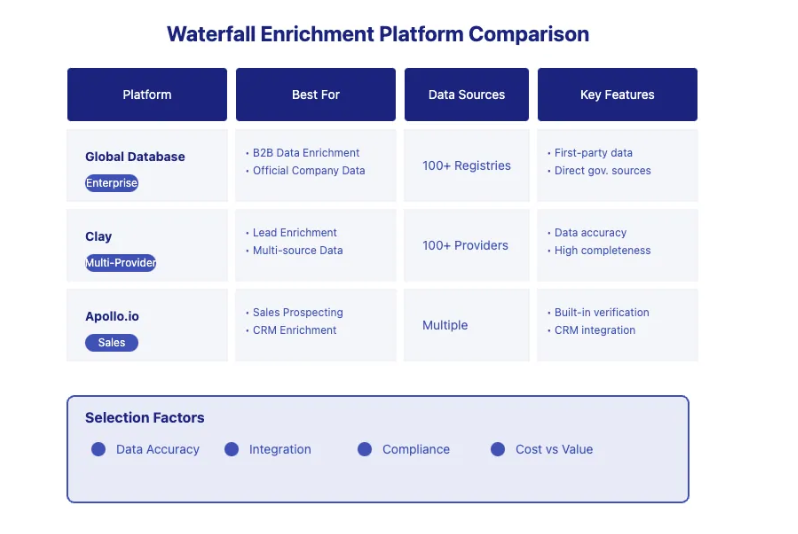
Implementing waterfall enrichment effectively requires the right tools and platforms that can seamlessly integrate multiple data sources to enhance your datasets. Here are some of the best options available:
1. Global Database (Best for Enterprise-Grade B2B Data Enrichment)
Global Database is a leading provider of first-party, government-sourced business data with direct access to over 100 local registries. Unlike many enrichment tools that rely on third-party sources, Global Database ensures unmatched accuracy and compliance by pulling data directly from official government sources.
2. Clay (Best for Multi-Provider Lead Enrichment)
Clay offers access to over 100 data providers, allowing users to maximize their lead coverage and enrichment. Its waterfall enrichment feature systematically searches multiple databases to ensure the highest data accuracy and completeness.
3. Apollo (Best for Sales Prospecting & CRM Enrichment)
Apollo provides a built-in waterfall enrichment tool that finds and verifies contact details across multiple data sources. The platform enhances CRM data by layering missing emails, phone numbers, and job titles through a structured enrichment process.
4. BetterContact (Best for High-Volume Email Verification & Lead Sourcing)
BetterContact integrates with 21+ data sources and offers a 99% email find rate, ensuring high email verification accuracy through multi-layered enrichment.
5. FullEnrich (Best for SMBs Looking for Budget-Friendly Enrichment)
FullEnrich connects to 15+ premium vendors using a waterfall enrichment approach to improve lead and account coverage with cost-effective pricing.
6. Lemlist (Best for Automated Outreach & Lead Enrichment)
Lemlist has implemented an automated waterfall lead enrichment process, ensuring that outbound campaigns reach verified, high-quality leads.
Choosing the Right Waterfall Enrichment Tool
When selecting a waterfall enrichment platform, consider:
🔹 Data Accuracy & Source Reliability – Does the platform source first-party data (like Global Database) or rely on third-party aggregators?
🔹 Integration Capabilities – Can it seamlessly connect with your CRM, marketing automation, and sales tools?
🔹 Compliance & Security – Is the provider GDPR/CCPA compliant, and does it follow ethical data practices?
🔹 Cost vs. Value – Does the ROI justify the investment in multi-layered enrichment?
By leveraging the right tools, businesses can implement a powerful waterfall enrichment strategy that enhances data accuracy, sales intelligence, and marketing performance.
Frequently Asked Questions (FAQs)
Even with a solid understanding of Waterfall Enrichment, businesses often have additional questions about how it works, its benefits, and how to implement it effectively. Below, we address some of the most common inquiries.
1. What is Waterfall Enrichment, and how does it differ from standard data enrichment?
Waterfall enrichment is a multi-step data enhancement process that retrieves information from multiple sources in a structured, sequential order. Unlike traditional enrichment, which pulls data from a single provider, waterfall enrichment prioritizes data sources and continues searching until all necessary fields are populated. This ensures higher accuracy, better completeness, and greater reliability in datasets.
2. What are the stages of the waterfall methodology?
Although waterfall enrichment is inspired by the waterfall methodology used in project management, it is specifically tailored for data enrichment. The key stages include:
1️⃣ Primary Data Source Check – The most reliable data provider is used first.
2️⃣ Secondary Data Source Check – If missing fields exist, a second provider is queried.
3️⃣ Tertiary Data Source Check – Further sources are tapped if needed.
4️⃣ Final Validation & Standardization – Data is verified and formatted consistently.
5️⃣ Continuous Updates – The process is repeated regularly to maintain accuracy.
3. Why is Waterfall Enrichment useful for B2B companies?
For B2B companies, data quality directly impacts lead generation, account-based marketing (ABM), and customer relationship management (CRM). Incomplete or inaccurate data leads to poor targeting, wasted outreach, and lost revenue opportunities. Waterfall enrichment ensures that B2B sales and marketing teams work with the most reliable data, leading to improved conversions and customer engagement.
4. How does Waterfall Enrichment benefit CRM systems?
CRM platforms thrive on accurate, structured, and enriched data. Waterfall enrichment:
✔ Fills missing data fields (e.g., company size, revenue, industry, and contact details)
✔ Reduces duplicate records and outdated information
✔ Enhances lead scoring with complete firmographic and technographic details
✔ Improves personalization for sales and marketing outreach
5. What are the common challenges of Waterfall Enrichment?
While beneficial, waterfall enrichment presents challenges such as:
⚠ Compliance Risks – Ensuring that multiple data sources comply with GDPR, CCPA, and other regulations.
⚠ Integration Complexity – Connecting multiple data sources with existing marketing and sales tech stacks.
⚠ Cost Considerations – Some providers charge per request, making multi-source enrichment expensive if not optimized.
6. How often should businesses update their data using Waterfall Enrichment?
The frequency of updates depends on the use case, but real-time or periodic updates (weekly or monthly) are recommended to maintain accuracy. Automating the process ensures data remains fresh and actionable.
7. Can Waterfall Enrichment be automated?
Yes! Many platforms, such as Global Database, Clay, and Apollo offer automated enrichment that seamlessly integrates with CRMs, marketing automation tools, and API-based workflows to keep data continuously updated.
8. What’s an example of a Waterfall Enrichment strategy in action?
A B2B SaaS company struggling with outdated contact records used Global Database as their primary enrichment provider. When missing emails or job titles were found, their system automatically queried Apollo and BetterContact as secondary sources. This layered approach increased their email match rate by 47%, leading to better lead qualification and a 30% boost in outreach success rates.
With Waterfall Enrichment, businesses can take data quality to the next level. Whether you're enriching lead data, optimizing your CRM, or ensuring compliance with regulatory requirements, a multi-layered approach to data enrichment ensures that every decision is backed by accurate, verified, and complete data.

